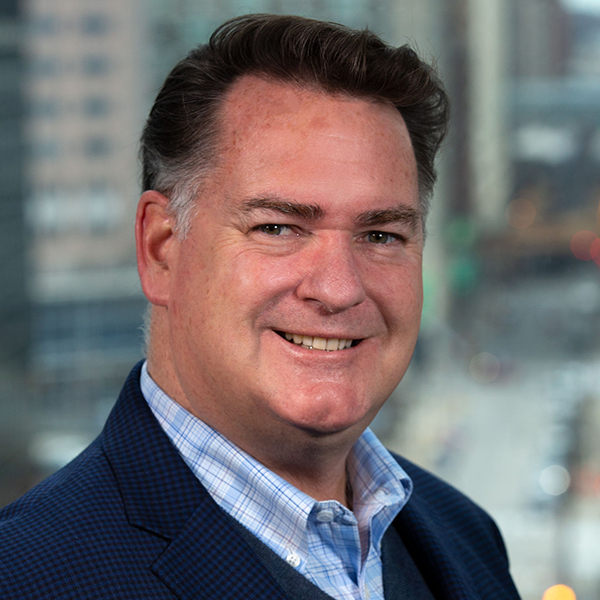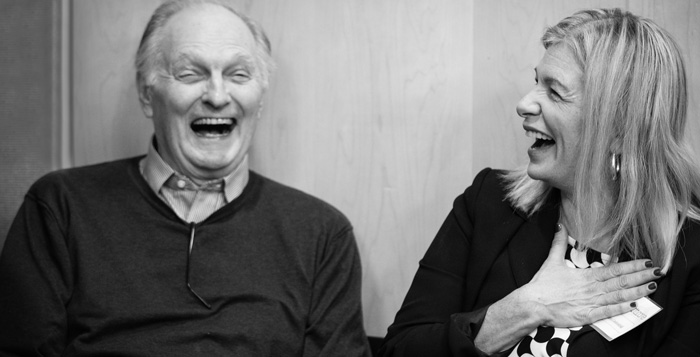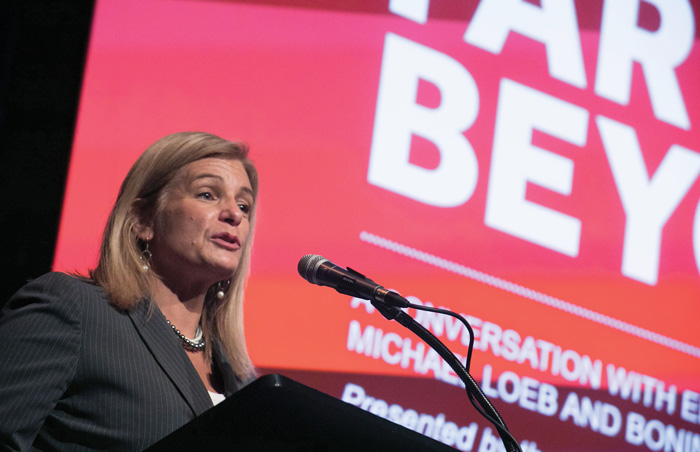
The Messy, Fine Art of Science Communication
The executive director of the Alan Alda Center for Communicating Science uses theatrical improv to help experts shed their inhibitions, focus less on looking smart, and think more about building trust with their audience.
Article Content
Science, at the moment, seems to have a bit of a confidence problem.
Although a solid majority (77%) of Americans say they have at least a fair amount of trust that scientists are acting in the public interest, only 29% describe a great deal of trust, according to a 2022 report by the Pew Research Center. And that figure is down 10 percentage points from 2022.
Further, the Pew study says nearly a quarter (22%), have little to no confidence in scientists. Divided partisan perspectives explain only some of the disconnect, as no political party reported a majority with high confidence.
Meanwhile, in its 2023 Edelman Trust Barometer Global Report, the worldwide communications firm noted that public trust in business now exceeds that of institutions, such as governments and media, and that 72% agreed that businesses should “expose questionable science used to justify bad social policy.”
Somewhere there is a disconnect between what’s being said and what’s being heard.
None of this surprises Laura Lindenfeld, dean of the School of Communication and Journalism at Stony Brook University and executive director of the Alan Alda Center for Communicating Science, which Stony Brook launched in 2009 as one of a handful of programs specifically focused on effective science communication.
Ultimately, she says, it comes down to trust. “A lot of people think communication is this transactional thing: If I say jump, hopefully you’ll jump because I’m trying to help you get out of the way of something,” she says. “But most communication really is relational and not transactional, and it’s embedded within relationships that have all kinds of power dynamics. The more you trust someone, the more likely you are to listen to them and believe them. And if we don’t take that into the equation of what communication is, we’re going to get it wrong.
“I think more and more we need to understand that when we put messaging out in any form,” she adds. “Because inevitably, people are never going to receive the information exactly as we send it.”
Building those connections is at the core of the Alan Alda Center’s mission, as well as its technique. Named after the award-winning actor, director, and science enthusiast, its training applies improvisational theater techniques to help experts better frame and present complex ideas.
Since taking the helm in 2016, Lindenfeld, a self-described foodie and co-author of a book about the intersection of food and culture, has expanded the center’s footprint in science communication research, as well as its workshop/consulting practice, which has hosted institutions ranging from Cornell and Harvard to the National Institutes of Health, the Environmental Protection Agency, and the U.S. Department of Defense.
Food Technology spoke with Lindenfeld about the essential ingredients for scientists to build trust and those critical connection points.
What makes the Alda Center unique relative to other communication or journalism programs?
Obviously, Alan Alda is a famous actor—he did M*A*S*H, and all those other shows. But he’s also a lifelong lover of science, and for 13 years he shot Scientific American Frontiers on PBS.
While he was doing this, he would get scientists on camera and find that when he could get them to make eye contact, really connect with him, the communication that came out of them was entirely different.
There was one incident where he was talking with a scientist. She would be telling wonderful stories and conveying information in such a relevant fashion. And then she’d remember the camera and she’d freeze. It’s like the white coat went back on. And he thought, well, let me coax her back out.
And then she’d freeze again. And he thought, I can’t do this with every scientist for the rest of time. What if we could train them using the training he had? The only training Alan had as an actor was improv, and it just struck him: “I’ll bet improv would help scientists communicate.”
He approached a bunch of universities in the greater New York metro area, and Stony Brook said, we’ll give that a shot. And thus in 2009 was born the Center for Communicating Science.
What’s unique about us is that we use improvisational theater combined with message strategy to train scientists to communicate as the genuine human beings that they are.
Where do the disconnects in effective communication typically occur?
One of the key challenges is that when you’re trained to be a scientist, you spend a lot of time learning very particular ways of talking about your work. And you need that language. You need that jargon. It’s shorthand. It’s an in-group way of connecting and moving the work forward. So, I don’t ever want to use the word jargon in a pejorative sense. But when you’re not a scientist, that just feels incredibly alienating, and it can even feel arrogant.
The second piece that’s quite common is that the way you’re trained to design science and communicate about it is pretty much the opposite of how people who are not scientists tend to perceive information.
Science is fairly defensive. You start out saying, all these other people made these conclusions, and you look at the entire landscape of everything that’s been done in your field. And then you narrow it down, and you defensively posture yourself to justify what you’re going to do. You look at some narrow phenomenon. You say what statistics you’re going to run and what theory you’re going to test. And then, at the very end, you make the conclusion.
When we’re training scientists, we’re teaching people to flip that pyramid and start with the bottom line for that audience.
The third piece is when you’re trained to be in science, you’re trained to do science. You’re not necessarily put into a world where you’re asked to appreciate the culture of people outside of science and think about how what you do might be worthwhile and meaningful to them.
When it comes to food, there’s something particularly visceral about things we put in our body and experience. And the more you talk about that with scientific rigor and distance, the more frightening it can feel.
What about all the so-called science skeptics? How can they be reached?
The reason we use improv is to help people relate and connect, so that they can approach engagement. Communication comes from the word community. And if our ideal here is to create a sense of community and belonging, which I think is critically important, it’s critical to trust, then training people to be empathic and understand where someone else is coming from is absolutely essential.
Alan loves this idea of the “curse of knowledge,” when you’re so used to understanding things one way, you forget what it feels like not to be you.
A lot of what this improv training does is it takes scientists out of their own lived experience and helps them to the best of our human ability put themselves in the shoes of someone else, so they can imagine what it feels and sounds like to hear what they’re communicating.
So really everything we’re doing in the Alda Center is rooted in building bridges, building empathy, building connections, and communicating in a way that what you want to convey is actually heard. It’s listener focused.
What is that person wanting, needing, caring about hearing, rather than, what do I want to say?
One of the two rules of improv is making your partner look good. And the other one is to say, “yes, and …” meaning you don’t have to agree with the content of another person. You may actually disagree with them, but you’re saying yes to their perception of reality and acknowledging their dignity.
Once you can, and we use this throughout our workshops, once you can mobilize those two premises, you’re creating a situation where listening and change are possible.
Let’s talk specifically about food, which is becoming such a polarizing topic, with deep divides over the role of technology, health impact, the role of processing. How can those conversations become more constructive?
Wow, this is such a tangled, complex set of issues, which is what drove me to [write about] food in the beginning. It’s so rooted in our sense of identity and community, and there’s so much political strife that runs through food.
One of the things I believe deeply is that the more science can engage with people who will potentially benefit or lose from the outcomes of that science—to genuinely understand what’s at stake for those people in communities, whether it’s we’re afraid of GMOs, or because of what it’s going to do to agriculture or to my body—the more you can listen and acknowledge so that people have felt heard, I think it could help us overcome some of the political challenges.
I’m not suggesting this is an easy fix. I really do think most scientists do their work in good faith, [but] the public doesn’t necessarily see that. By the time that information gets to them, it’s typically coming through marketing, which is separate and maybe citing science that isn’t actually scientific.
So, it’s less about what people explicitly say, and more about their underlying motivations?
Yes. Scientists have to show up with humility and a genuine willingness to listen. I was involved in a pretty large sustainable aquaculture project when I was at University of Maine. And it’s remarkable how many misperceptions are out there about something like salmon farming. People just have an allergic reaction. But if you don’t know that and you just go out there pushing, you may actually make the problem worse.
So, understanding how people perceive, especially around environmental issues, food issues, biomedical solutions, things that are tangibly going to affect people’s bodies, there’s this increased threshold of worry and anxiety.
What is at stake for people? What do they really care about? Then think about not just what is the message, but who are the right messengers?
People know when you’re pretending to listen … we checked the box, we made eye contact, we pretended to listen. Everything we’re after in the Alda Center runs that spectrum of how you get your message out in such a way that it really lands, because you’re genuinely listening and hearing and taking people seriously.
Earlier, you said you need to enter a conversation with the end in mind. Can you expand on that?
Why would this person care? That’s incumbent upon you as the speaker or writer: Do your homework. What’s at stake for them?
We walk people through tools and exercises to get them to imagine what would make this person want to pay attention. They’re not going to pay attention to you just because you think you’re important. You can actually make this problem worse. There’s this backfire effect. If someone already disbelieves, for example, in climate change very strongly, the more you talk about climate change, the more they’re going to see a distance between you and them and disbelieve you even more.
We’re entering a brave new world of food production—precision fermentation, cellular agriculture, plant-based. Many find it incredibly exciting; for others, it’s terrifying. It seems having the ability to demystify these changes is only going to get more important.
I think that’s true. A lot of the research work that I did was studying how we represent food in narrative films. A lot of the information people get is through advertising, television shows. Look at how many people follow the Food Network or Cooking Channel. And there’s a lot of poor information, a lot of contradictory information.
But I think we can’t just think about this as a scientist communicating to a community. Food circulates across media in profoundly important ways. We’ve got to understand that whole context in which people engage with food through media.
This discourse about food is not just about what you put in your mouth. It’s about who you are; it’s about your gender, ethnicity, sexual identity.
Every year, the Edelman global communications firm publishes its trust barometer. In the 2023 survey, 72% said that they believe businesses are obligated to “expose questionable science used to justify bad social policy.” That’s a large number. What is it saying?
A [colleague] named Chris Volpe runs an organization called ScienceCounts. He looks at Americans’ perceptions of science. What you see when you look at his data is that people tend to look at science the way they look at music. So, if you ask Americans, do you like music? Everybody says, well, yes, I love music. Do you like opera? Well, no, not so much. Do you like country music? Oh, I hate country music.
People tend to see science like that—you get to pick and choose which science you like. So, depending on your political party, your educational level, to some degree, your gender, ethnicity, etc., you like some parts of science better than others.
I think that’s something we need to be mindful of when we communicate science: Who do people trust? “Well, I don’t trust the work that’s done by universities, but I trust the science that’s done by corporations.” And that tends to fall a bit along partisan lines.
Add to that a cognitive load for consumers: How much can you think about this? I’m someone who studies food and communication and science. And boy, if I’m overwhelmed with this, and I care about it and I’m involved in these things professionally, you’re asking a lot of people to discern.
Vital Statistics
Experience: Dean of the School of Communication and Journalism, Stony Brook University; Executive Director, Alan Alda Center for Communicating Science at Stony Brook University; Professor of Journalism, Stony Brook University; Senior Research Fellow, University of Maine
Education: PhD, Cultural Studies, University of California, Davis
Expertise: Communicating science to diverse audiences; environmental communication; food systems; science, health, and environmental journalism; public engagement with science; media studies
Boards & Councils: International Environmental Communication Association; National Communication Association; Association for the Study of Food and Society; Editorial Board, Environmental Communication: A Journal of Nature and Culture
Noteworthy: Co-author, with Fabio Parasecoli, Feasting Our Eyes: Food Films and Cultural Identity in the United States (Columbia University Press 2016)
Favorite Quote: “The single biggest problem in communication is the illusion that it has taken place.” –George Bernard Shaw, Irish playwright











